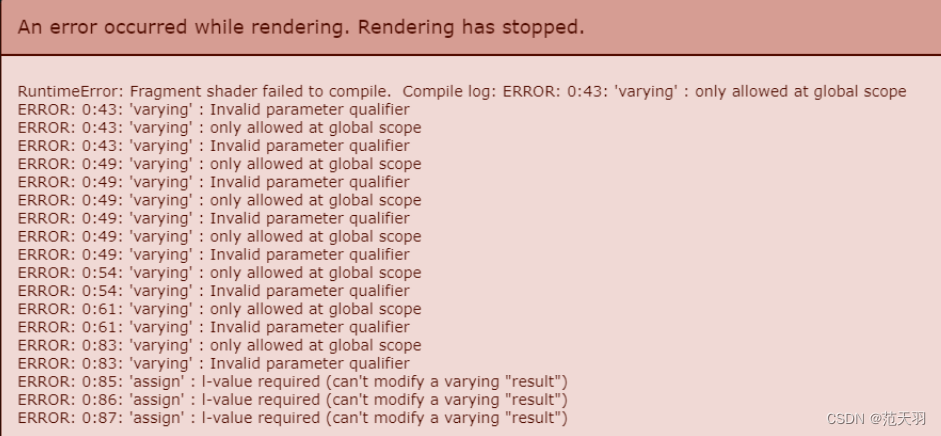项目场景:
我正在实现一个基于cesium的106版本的可视域分析,因为之前在1.96版本做个一个,我就直接平移了代码
问题描述
当我执行功能模块的时候出现了错误 varying:only allowed at global scope

部分代码
const postStage = new Cesium.PostProcessStage({
fragmentShader: `
#define USE_CUBE_MAP_SHADOW true
uniform sampler2D colorTexture;
uniform sampler2D depthTexture;
varying vec2 v_textureCoordinates;
uniform mat4 camera_projection_matrix;
uniform mat4 camera_view_matrix;
uniform samplerCube shadowMap_textureCube;
uniform mat4 shadowMap_matrix;
uniform vec4 shadowMap_lightPositionEC;
uniform vec4 shadowMap_normalOffsetScaleDistanceMaxDistanceAndDarkness;
uniform vec4 shadowMap_texelSizeDepthBiasAndNormalShadingSmooth;
uniform float helsing_viewDistance;
uniform vec4 helsing_visibleAreaColor;
uniform vec4 helsing_invisibleAreaColor;
struct zx_shadowParameters
{
vec3 texCoords;
float depthBias;
float depth;
float nDotL;
vec2 texelStepSize;
float normalShadingSmooth;
float darkness;
};
float czm_shadowVisibility(samplerCube shadowMap, zx_shadowParameters shadowParameters)
{
float depthBias = shadowParameters.depthBias;
float depth = shadowParameters.depth;
float nDotL = shadowParameters.nDotL;
float normalShadingSmooth = shadowParameters.normalShadingSmooth;
float darkness = shadowParameters.darkness;
vec3 uvw = shadowParameters.texCoords;
depth -= depthBias;
float visibility = czm_shadowDepthCompare(shadowMap, uvw, depth);
return czm_private_shadowVisibility(visibility, nDotL, normalShadingSmooth, darkness);
}
vec4 getPositionEC(){
return czm_windowToEyeCoordinates(gl_FragCoord);
}
vec3 getNormalEC(){
return vec3(1.);
}
vec4 toEye(in vec2 uv,in float depth){
vec2 xy=vec2((uv.x*2.-1.),(uv.y*2.-1.));
vec4 posInCamera=czm_inverseProjection*vec4(xy,depth,1.);
posInCamera=posInCamera/posInCamera.w;
return posInCamera;
}
vec3 pointProjectOnPlane(in vec3 planeNormal,in vec3 planeOrigin,in vec3 point){
vec3 v01=point-planeOrigin;
float d=dot(planeNormal,v01);
return(point-planeNormal*d);
}
float getDepth(in vec4 depth){
float z_window=czm_unpackDepth(depth);
z_window=czm_reverseLogDepth(z_window);
float n_range=czm_depthRange.near;
float f_range=czm_depthRange.far;
return(2.*z_window-n_range-f_range)/(f_range-n_range);
}
float shadow(in vec4 positionEC){
vec3 normalEC=getNormalEC();
zx_shadowParameters shadowParameters;
shadowParameters.texelStepSize=shadowMap_texelSizeDepthBiasAndNormalShadingSmooth.xy;
shadowParameters.depthBias=shadowMap_texelSizeDepthBiasAndNormalShadingSmooth.z;
shadowParameters.normalShadingSmooth=shadowMap_texelSizeDepthBiasAndNormalShadingSmooth.w;
shadowParameters.darkness=shadowMap_normalOffsetScaleDistanceMaxDistanceAndDarkness.w;
vec3 directionEC=positionEC.xyz-shadowMap_lightPositionEC.xyz;
float distance=length(directionEC);
directionEC=normalize(directionEC);
float radius=shadowMap_lightPositionEC.w;
if(distance>radius)
{
return 2.0;
}
vec3 directionWC=czm_inverseViewRotation*directionEC;
shadowParameters.depth=distance/radius-0.0003;
shadowParameters.nDotL=clamp(dot(normalEC,-directionEC),0.,1.);
shadowParameters.texCoords=directionWC;
float visibility=czm_shadowVisibility(shadowMap_textureCube,shadowParameters);
return visibility;
}
bool visible(in vec4 result)
{
result.x/=result.w;
result.y/=result.w;
result.z/=result.w;
return result.x>=-1.&&result.x<=1.
&&result.y>=-1.&&result.y<=1.
&&result.z>=-1.&&result.z<=1.;
}
void main(){
// 釉色 = 结构二维(颜色纹理, 纹理坐标)
gl_FragColor = texture2D(colorTexture, v_textureCoordinates);
// 深度 = 获取深度(结构二维(深度纹理, 纹理坐标))
float depth = getDepth(texture2D(depthTexture, v_textureCoordinates));
// 视角 = (纹理坐标, 深度)
vec4 viewPos = toEye(v_textureCoordinates, depth);
// 世界坐标
vec4 wordPos = czm_inverseView * viewPos;
// 虚拟相机中坐标
vec4 vcPos = camera_view_matrix * wordPos;
float near = .001 * helsing_viewDistance;
float dis = length(vcPos.xyz);
if(dis > near && dis < helsing_viewDistance){
// 透视投影
vec4 posInEye = camera_projection_matrix * vcPos;
// 可视区颜色
// vec4 helsing_visibleAreaColor=vec4(0.,1.,0.,.5);
// vec4 helsing_invisibleAreaColor=vec4(1.,0.,0.,.5);
if(visible(posInEye)){
float vis = shadow(viewPos);
if(vis > 0.3){
gl_FragColor = mix(gl_FragColor,helsing_visibleAreaColor,.5);
} else{
gl_FragColor = mix(gl_FragColor,helsing_invisibleAreaColor,.5);
}
}
}
}`,
uniforms: {}
});
尝试的方式:
(1)创建容器的时候开启webgl1
viewer=new Cesium.Viewer(containerId,{
infoBox: false,
contextOptions: {
requestWebgl1: true
}
})
(2)修改varying,为in/out,始终都不行;
(3)尝试把有的方法的参数的in 去掉,后来就可以了,本人对GLSL不怎么研究过,具体原因不知道为啥。
export default `
#define USE_CUBE_MAP_SHADOW true;
uniform sampler2D colorTexture;
uniform sampler2D depthTexture;
varying vec2 v_textureCoordinates;
uniform mat4 camera_projection_matrix;
uniform mat4 camera_view_matrix;
uniform samplerCube shadowMap_textureCube;
uniform mat4 shadowMap_matrix;
uniform vec4 shadowMap_lightPositionEC;
uniform vec4 shadowMap_normalOffsetScaleDistanceMaxDistanceAndDarkness;
uniform vec4 shadowMap_texelSizeDepthBiasAndNormalShadingSmooth;
uniform float helsing_viewDistance;
uniform vec4 helsing_visibleAreaColor;
uniform vec4 helsing_invisibleAreaColor;
struct zx_shadowParameters
{
vec3 texCoords;
float depthBias;
float depth;
float nDotL;
vec2 texelStepSize;
float normalShadingSmooth;
float darkness;
};
float czm_shadowVisibility(samplerCube shadowMap, zx_shadowParameters shadowParameters)
{
float depthBias = shadowParameters.depthBias;
float depth = shadowParameters.depth;
float nDotL = shadowParameters.nDotL;
float normalShadingSmooth = shadowParameters.normalShadingSmooth;
float darkness = shadowParameters.darkness;
vec3 uvw = shadowParameters.texCoords;
depth -= depthBias;
float visibility = czm_shadowDepthCompare(shadowMap, uvw, depth);
return czm_private_shadowVisibility(visibility, nDotL, normalShadingSmooth, darkness);
}
vec4 getPositionEC(){
return czm_windowToEyeCoordinates(gl_FragCoord);
}
vec3 getNormalEC(){
return vec3(1.);
}
vec4 toEye( vec2 uv, float depth){
vec2 xy=vec2((uv.x*2.-1.),(uv.y*2.-1.));
vec4 posInCamera=czm_inverseProjection*vec4(xy,depth,1.);
posInCamera=posInCamera/posInCamera.w;
return posInCamera;
}
vec3 pointProjectOnPlane( vec3 planeNormal, vec3 planeOrigin, vec3 point){
vec3 v01=point-planeOrigin;
float d=dot(planeNormal,v01);
return(point-planeNormal*d);
}
float getDepth( vec4 depth){
float z_window=czm_unpackDepth(depth);
z_window=czm_reverseLogDepth(z_window);
float n_range=czm_depthRange.near;
float f_range=czm_depthRange.far;
return(2.*z_window-n_range-f_range)/(f_range-n_range);
}
float shadow( vec4 positionEC){
vec3 normalEC=getNormalEC();
zx_shadowParameters shadowParameters;
shadowParameters.texelStepSize=shadowMap_texelSizeDepthBiasAndNormalShadingSmooth.xy;
shadowParameters.depthBias=shadowMap_texelSizeDepthBiasAndNormalShadingSmooth.z;
shadowParameters.normalShadingSmooth=shadowMap_texelSizeDepthBiasAndNormalShadingSmooth.w;
shadowParameters.darkness=shadowMap_normalOffsetScaleDistanceMaxDistanceAndDarkness.w;
vec3 directionEC=positionEC.xyz-shadowMap_lightPositionEC.xyz;
float distance=length(directionEC);
directionEC=normalize(directionEC);
float radius=shadowMap_lightPositionEC.w;
if(distance>radius)
{
return 2.0;
}
vec3 directionWC=czm_inverseViewRotation*directionEC;
shadowParameters.depth=distance/radius-0.0003;
shadowParameters.nDotL=clamp(dot(normalEC,-directionEC),0.,1.);
shadowParameters.texCoords=directionWC;
float visibility=czm_shadowVisibility(shadowMap_textureCube,shadowParameters);
return visibility;
}
bool visible( vec4 result)
{
result.x/=result.w;
result.y/=result.w;
result.z/=result.w;
return result.x>=-1.&&result.x<=1.
&&result.y>=-1.&&result.y<=1.
&&result.z>=-1.&&result.z<=1.;
}
void main(){
// 釉色 = 结构二维(颜色纹理, 纹理坐标)
gl_FragColor = texture2D(colorTexture, v_textureCoordinates);
// 深度 = 获取深度(结构二维(深度纹理, 纹理坐标))
float depth = getDepth(texture2D(depthTexture, v_textureCoordinates));
// 视角 = (纹理坐标, 深度)
vec4 viewPos = toEye(v_textureCoordinates, depth);
// 世界坐标
vec4 wordPos = czm_inverseView * viewPos;
// 虚拟相机中坐标
vec4 vcPos = camera_view_matrix * wordPos;
float near = .001 * helsing_viewDistance;
float dis = length(vcPos.xyz);
if(dis > near && dis < helsing_viewDistance){
// 透视投影
vec4 posInEye = camera_projection_matrix * vcPos;
// 可视区颜色
// vec4 helsing_visibleAreaColor=vec4(0.,1.,0.,.5);
// vec4 helsing_invisibleAreaColor=vec4(1.,0.,0.,.5);
if(visible(posInEye)){
float vis = shadow(viewPos);
if(vis > 0.3){
gl_FragColor = mix(gl_FragColor,helsing_visibleAreaColor,.5);
} else{
gl_FragColor = mix(gl_FragColor,helsing_invisibleAreaColor,.5);
}
}
}
}
`;
如有人觉得侵权请联系我,谢谢





















 2779
2779











 被折叠的 条评论
为什么被折叠?
被折叠的 条评论
为什么被折叠?








